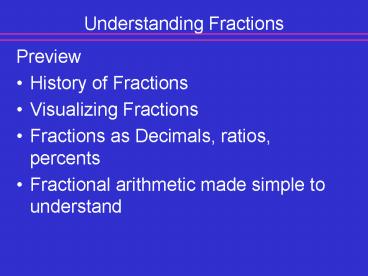Understanding Fractions - PowerPoint PPT Presentation
1 / 29
Title:
Understanding Fractions
Description:
... method of writing common fractions is due essentially to ... fractions. ... Adding Fractions. Subtracting Fractions. Multiplication. Division. Total= 6. How many ... – PowerPoint PPT presentation
Number of Views:279
Avg rating:3.0/5.0
Title: Understanding Fractions
1
Understanding Fractions
- Preview
- History of Fractions
- Visualizing Fractions
- Fractions as Decimals, ratios, percents
- Fractional arithmetic made simple to understand
2
Brief History of Fractions
- Earliest Notation of Fractions
- Babylonians (3000 2000 B.C.)
1 x 600 24 x 60-1 51 x 60-2 10 x 60-3, or
about 1.414222 approximation of square root of 2.
Place holder or zero
Ten
One
3
- The earliest Egyptian and Greek fractions were
usually unit fractions (having a numerator of 1),
so that the fraction was shown simply by writing
a numeral with a mark above or to the right
indicating that the numeral was the denominator
of a fraction. - Greeks mostly thought of fractions as part of a
whole or as ratios. - Ancient Rome. The Romans did not use numerals to
indicate fractions, but instead used words to
indicate parts of a whole.
4
- Our method of writing common fractions is due
essentially to the Hindus, although they did not
use the bar. Brahmagupta (c. 628) and Bhaskara
(c. 1150) wrote fractions as we do today but
without the bar. - The horizontal fraction bar was introduced by the
Arabs. "The Arabs at first copied the Hindu
notation, but later improved on it by inserting a
horizontal bar between the two numbers" (around
c. 1200 by al-Hassar).
5
- Fibonacci (c.1175-1250) was the first European
mathematician to use the fraction bar as it is
used today. - The diagonal fraction bar (also called a solidus
or virgule) was introduced because the horizontal
fraction bar was difficult typographically.
6
- An early handwritten document with forward
slashes in lieu of fraction bars is seen in
Thomas Twining's Ledger of 1718, where quantities
of tea and coffee transactions are listed, e.g.
1/4 pound green tea. - Decimal fractions. Abu'l Hasan Ahmad ibn Ibrahim
Al-Uqlidisi (c. 920-c. 980) wrote the earliest
known text offering a direct treatment of decimal
fractions.
7
- The use of a decimal point generally is
attributed either to G. A. Magini (1555-1617), a
map-making friend of Kepler and appeared in a
table of sines around 1593. But the decimal point
did not become popular until Napier used it more
than twenty years later. - The percent symbol is believed to have evolved
from a symbol introduced in an anonymous Italian
manuscript of about 1425.
8
Visualizing Fractions
- Concept of Fraction
9
Fractions As Numbers
10
Fractions as Decimals
11
Fractions as Ratios and Percentages
- Use 12 ratio of rice is to water, to make rice
- A student got 80 on the test.
- The ratio of male to female in this room is ?
- The interest on a checking account is barely 1
in the last month.
12
- DEF- A fraction is a number that can be
represented by an ordered pair of whole numbers
where b?0. In set notation Fa/b a and b whole
nos and b?0.
13
Equal Fractions
14
Equal Fractions
- Let a/b and c/d be two fractions. Then
iff adbc. Let a/b be any fraction and n be a
nonzero number then
15
Adding Fractions
16
(No Transcript)
17
Subtracting Fractions
18
(No Transcript)
19
Multiplication
20
?
21
(No Transcript)
22
Division
Total 6
23
How many ¾ fit into 5
24
Review of last division problem
That is 6 groups plus 2 pieces out 3 left.
25
How many 2/7 fit into 5/3?
2/3
1/3
3/3
5/3
4/3
26
How many 2/7 fit into 5/3?
27
(No Transcript)
28
(No Transcript)
29
THE END!































